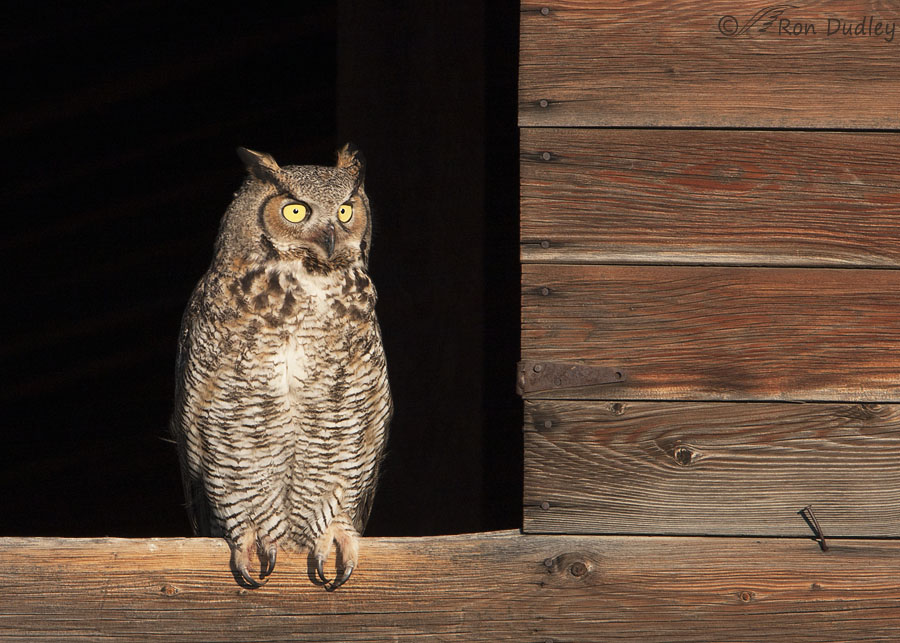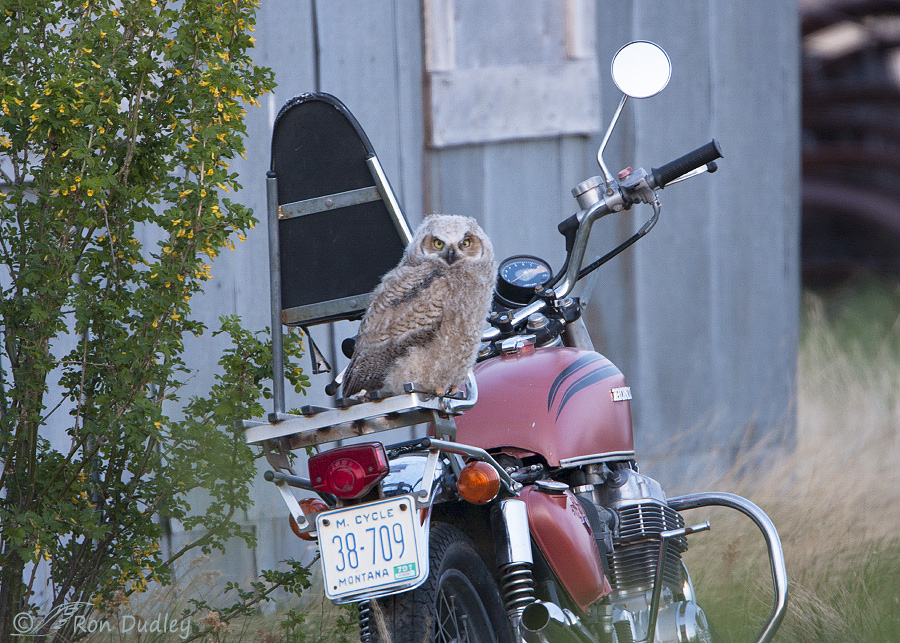Yesterday’s post has me wandering down memory lane again.
After I bought my new birding lens with part of the ‘gift’ I received from cousin Ken Dudley after he passed away it took me a while to get back to the Montana family farm and photograph the Great Horned Owls that at the time were my ultimate goal. After all, with Ken gone there would be no one living out there and I knew it would be lonely and sad.
But I also knew I’d have to do it eventually and the owls were calling me so I bucked up and started going back.

1/800, f/8, ISO 400, Canon 40D, Canon EF 500mm f/4L IS USM + EF 1.4 III Extender, not baited, set up or called in
I photographed this adult Great Horned Owl in one of the old granaries on one of my first trips back. The photo was taken at 5:37 AM, only minutes after sunrise, so the light was extremely warm and the owl’s eyes almost seem to glow.
We can tell how low the sun is on the horizon by the catch lights that are so low on the owl’s cornea they’re actually in front of the owl’s almost pinpoint pupils. For reasons that should be apparent we never see a catch light on the lower half of the eye that originates directly from the sun. However, we do see catch lights on the lower half of the eye if they’re reflected off of water or something else in front of and below the bird.
Several years ago I posted four varying compositions of a different photo of this same owl because I couldn’t decide which composition I preferred. With feedback from readers I eventually chose this composition that includes the bent-over rusty nail at bottom right. My grandfather, uncle or even possibly my father would have pounded that nail back in the early 30’s and knowing each one of them as I did I’m confident there were some cuss words involved when the nail was bent. For me that’s part of the charm and nostalgia of the photo.
 1/30, f/5.6, ISO 500, Canon 40D, Canon EF 500mm f/4L IS USM + EF 1.4 III Extender, not baited, set up or called in
1/30, f/5.6, ISO 500, Canon 40D, Canon EF 500mm f/4L IS USM + EF 1.4 III Extender, not baited, set up or called in
As an afterthought I’m including this photo that I’ve posted before because it’s a perfect example of one I’d have absolutely no chance of getting if I’d been using my much smaller and slower old lens instead of ‘Ken’s lens’.
It was taken in the predawn darkness when I found this fledgling Great Horned Owl perched on an old junked Honda 750 motorcycle that belonged to my uncle Floyd, Ken’s father. Some years earlier when Ken and Floyd were living alone on the farm they had matching Honda 250’s that they liked to ride into nearby Glacier National Park. But Ken wrecked his, almost losing his life in the process, so Floyd stopped riding his for obvious reasons.
I was handholding my lens when I took this shot in such low light that my shutter speed was only 1/30. At this focal length and shutter speed I’m amazed it’s as sharp as it is. With my old lens I’d have never had the reach or the shutter speed to get this shot.
Largely for nostalgic reasons it’s one of my favorite photos of all time.
Ron
Notes:
- Photographers reading this will probably wonder why I didn’t increase my ISO to get more shutter speed for the motorcycle photo. Back then I wasn’t smart enough to even think about it in time, much less get it done.
- Some readers may be getting eye strain trying to read the sticker on the license plate indicating the last year it was registered. It was 1979.


Oldies but goodies; yours are a hoot (groan).
Caution: nerdy info to follow. I like to look up the english translations of scientific names. The 1980 book “The Audubon Society Encyclopedia of North American Birds” by John K. Terres has Bubo as latin for owl. A book I just got, “Latin for Bird Lovers” published in 2014 by Lederer and Burr translates it from the greek for swelling. Makes me glad that we use the English names for birds.
Thanks, Lyle. Each system has advantages and disadvantages. Personally I’m glad we use both. If nothing else it makes life more interesting for us bird lovers…
These owl images never fail to please (especially youngster riding bike). And your Montana farm stories always take me back to my own childhood memories of my dad’s family on the Sask. prairie (my grandfather was co-owner of a grain elevator, where I spent lots of time every summer). Sadly, I don’t remember much about any birds back then though I’m sure they were all around.
Chris, when I was growing up on the farm I didn’t pay as much attention to birds as I now wish I had. I think I paid them more attention than most kids my age, but still…
I look forward to your excellent post everyday Ron. Thank you.
Good to know, Linda. Thanks.
I enjoy the nostalgia and stories. I wonder, did you tell the story to the person who bought “Kens lens” when you sold it to upgrade to the newer version? I like it when things I buy come with a history.
April, I can’t remember for sure if I told him or not. But knowing me I probably did if the opportunity arose. I sometimes wonder how he’s doing with that lens – it was a great piece of glass, but heavy.
Thanks to the touching stories you’ve shared — and your skill in telling them –about the Montana farm(s), I feel a sense of “coming home” every time you share photos.
These two are among my favorites. GHOs are my favorite owl (sorry, Shorties). The granary shot has a sense of wistfulness and longing that really touches me today, especially with the bent nail. Today, for I think the first time, I noticed the slightly scalloped edge of the window to the owl’s right, along with a little bit of whitewash. I wonder if the generations of owls or the generations of Dudleys made the indentations (I’m pretty sure Dudleys didn’t make the whitewash ). The youngster has a “tough guy come at me bro” look and sitting on the motorcycle just makes the whole image for me!
). The youngster has a “tough guy come at me bro” look and sitting on the motorcycle just makes the whole image for me! 
Marty, I’m delighted you appreciate the farm photos.
That scalloping caused by wear would have been mostly caused by grain augers. When we’re loading grain into the granaries the augers would often rest right on the lip of the cutout, especially in the old days before we had better augers. The augers vibrate so they’d wear the wood. But generations of owls perched there sure would have contributed some to the wear.
The discoloration of the wood around the owl’s feet causing the wood to be more red would have been caused exclusively by the feet and talons of roosting owls over the years.
I always enjoy your “stories” as much as your beautiful photography !
Good to know, Laurel. Thank you.
I would find it very hard to emerge from memory lane again after an excursion like this. Very, very hard.
Thank you.
Thanks, EC.
I stumbled upon a Saw-whet just last week by sheer accident. I was out for a walk in the middle of the day and came upon scat in the snow. I looked up and there he was in the tree directly above me.
As luck would have it my camera was on Electronic Shutter which is absolutely silent. He turned his head around, looked down at me, and went back to sleep.
https://www.flickr.com/photos/101662735@N02/50799384092/in/dateposted-public/
Neat. Hope you didn’t have your mouth open…
The Saw-whet shot is adorable! I kept shuffling through some of your photos and your eagle shots are incredibly special! I love the shot with the two Bald Eagles in the nest — it looks like the one is describing the fish that got away.
Thanks Marty. The bird on the right is the male. He’s new this year. Last years male seems to have vanished.
That is an awesome shot—congrats (and lucky you to be in right place at right time w/ right equipment)!
Thanks Chris. Canon R5 + 100-400 II. My walk around setup.
I love the motorcycle one.
Thanks, Arwen.
Beautiful and fun! I remember well how you came about your first “good” lens and Ken’s part in that. I also remember and love the GHO’s at the granary being surprised they were out in daylight. The young owl is fun as I KNOW they have to “learn” to perch and often fall off of what they chose to sleep on – whatever works. Wonderful walk down memory lane……
Wonderful walk down memory lane……
Thanks, Judy. The owls are rarely out and about anywhere near midday. You either have to get up early or see if you can find them near sunset, which often isn’t easy to do. Personally I prefer mornings for a variety of reasons.
That is a beautiful photo! I really like the horizontal wood graining setting the horizontal markings of the owl’s feathers off. Also the stark blackness just makes the wood grain all the more prominent and warm. I’m always amazed at what we see when we go back and study photos; you may not have even been aware of the bent nail when you were zeroing in on the owl nor all the other details that contribute.
Kathy, without doubt I was completely unaware of that bent nail when I was taking the photo. It’s funny how elements you’re unaware of when you’re taking the photo eventually become so important in the finished product.
Nostalgic looks into the past are always welcome. Very heart warming post, and yes we have all bent nails like that at sometime in the past and possibly even in the present.
I have forgotten, but does your Dudley family still own at farm?
Thanks, Everett. Folks today would use nail guns to build granaries. They probably have little concept of what it’s like to spend all day, for weeks on end, pounding 10 penny nails using hammers. I’m old enough to know what it’s like.
Yes, Ken’s siblings still own most of the farm. And I still go back occasionally, although because of my bad back it’s been a while.